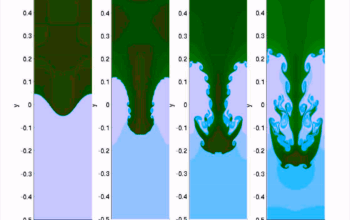The exploration of gas giants, such as Jupiter and Saturn, unveils a plethora of phenomena that challenge our comprehension and provoke intriguing scientific inquiry. These massive planets, forming predominantly from hydrogen and helium, exhibit characteristics that often defy conventional expectations. The complexities associated with their atmospheres, magnetic fields, and internal structures contribute to an overarching concept often termed “Gas Giant Chaos.” This term encapsulates the myriad uncertainties that persist despite significant advancements in observational and theoretical astrophysics.
At the core of understanding gas giants lies their atmospheric dynamics. The atmospheres of these colossal bodies are not merely vast layers of gases; they are dynamic environments characterized by intricate flows, vortices, and storm systems. The existence of colossal storms, such as Jupiter’s Great Red Spot, exemplifies the chaotic nature of gas giant atmospheres. These storms can rival the size of Earth and display longevity far beyond terrestrial weather systems. Researchers theorize that the mechanisms governing such weather patterns are rooted in the complex interplay between thermal dynamics, the conservation of angular momentum, and turbulent energy cascade.
Moreover, the role of convection in gas giant atmospheres warrants attention. Convection, instigated by temperature gradients, prompts the vertical movement of air, which subsequently leads to the formation of clouds and storms. However, the depth of these convective layers remains ambiguous. While models suggest that they extend deep into the gas giant’s interior, observational data from spacecraft missions often yield conflicting interpretations. This inconsistency raises pertinent questions: How deep do these convective currents penetrate? Do they interact with different layers of the planets in ways not yet accounted for?
In tandem with atmospheric phenomena, the internal structure of gas giants remains enigmatic. Unlike terrestrial planets, the interiors of gas giants are believed to be composed of molecular, metallic, and even exotic ices under extreme pressures and temperatures. The transitional zones between these states are poorly understood, leading to debates about the particular processes occurring within. For instance, the transition from gaseous hydrogen to metallic hydrogen poses profound implications for understanding the magnetic fields of these planets. The complexities associated with the generation of such fields stem from dynamo processes, which are still a topic of considerable research.
The examination of magnetic fields reveals yet another layer of complexity present in gas giant chaos. Jupiter’s magnetic field, which is about 20,000 times stronger than Earth’s, intricately interacts with its moons, radiation belts, and surrounding plasma. The study of these magnetic fields extends beyond mere curiosity, as they provide insights into the internal dynamics and evolutionary history of the gas giants. However, the exact mechanisms of magnetic field generation remain partially elusive. Are these fields powered by thermal convection, or do other processes contribute significantly?
Furthermore, the existence of multiple moons around these planets adds an additional dimension to the chaos. The moons of gas giants exhibit diversity in composition, size, and geological history. Some, like Europa, are considered prime candidates for astrobiological research due to their subsurface oceans beneath icy crusts. Others, such as Io, are sites of intense geological activity, attributed to tidal heating caused by gravitational interactions with nearby celestial bodies. Understanding these moons and their interactions with the gas giants underscores the need for comprehensive models that incorporate not just planetary physics but also celestial mechanics.
In the realm of astrophysics, the implications of gas giant chaos extend to exoplanetary studies. With the advent of advanced telescope technology, astronomers have detected numerous exoplanets that resemble Jupiter and Saturn, albeit at varied distances from their host stars. The atmospheric characteristics observed in these exoplanets showcase patterns and anomalies reminiscent of those found in our solar system’s gas giants. However, the extrapolation of models based solely on our solar system may prove perilous. Each system presents unique conditions, presenting further challenges to our understanding of gas giant formation and evolution.
Additionally, the theoretical frameworks employed to model these celestial bodies frequently encounter limitations. Standard models often rely on assumptions that may be oversimplified, overlooking crucial physical processes. For example, the assumption that gas giants form solely through accretion could omit aspects of direct gravitational collapse or the significance of initial planetesimal fragmentation. As research progresses, the development of more sophisticated computational models becomes imperative for refining our grasp of gas giant dynamics.
The future of gas giant studies holds great promise as technological advancements enable deeper exploration. The deployment of high-resolution imaging and spectroscopic analysis from missions such as the James Webb Space Telescope allows astronomers to obtain unprecedented views of gas giants, revealing spectral lines that can shed light on atmospheric composition, temperature fluctuations, and weather systems. The collision of observational data with theoretical models continues to drive the forward momentum of understanding gas giant chaos.
In conclusion, the exploration of gas giants remains imbued with a duality of fascination and frustration. The complexities of their atmospheric dynamics, internal structures, magnetic fields, and intricate moon systems coalesce into a tapestry of chaos that eludes full comprehension. While remarkable strides have been made in understanding these celestial behemoths, the realization that profound mysteries persist compels ongoing inquiries into the realms of planetary science. It is this very uncertainty that fosters excitement within the scientific community, as each discovery reveals more questions than answers, propelling the quest for knowledge about these magnificent gas giants forward.












